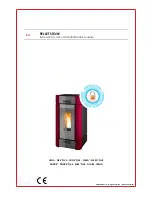
18
19
Description of the Sauna Stoves with
Net Frames
The sauna stove is surrounded by a
net frame. The stove consists of a fire
pocket, beneath which there is an
ash pan, and on the sides as well as
on top - a fireplace. In the middle, a
trapezoidal exhaust flue is located.
At the end of the exhaust flue, an af
-
terburner is installed. Between the fire
pocket and the ash pan, a narrow
cast-iron combustion grate is located.
Both the door of the fire pocket and
the combustion grate are located so
as to form a kind of threshold to pre
-
vent coal from falling out when add
-
ing fuel (also see Drawing 11: Cross
Section of the Sauna Stove). The user
must install the door knob included in
the sauna stove set along with the re-
quired fasteners. Combustion air pass
-
es through the ash pan and the grate.
The afterburner has two flue openings
(Ø115 mm), with access to the smoke
flue in the rare wall of the stove, or to
the top. The trapezoidal exhaust flue
has two cleanout holes. The stove can
be ordered with a water heater, the
volume of which reaches 3 litres. The
water heater can be welded to all the
internal walls of the stove: on the left,
right, or in the rear part. Two nipples
(external thread ¾) enable water out
-
flow and inflow. Heating the stove with
a water heater is only possible when
it is connected to a hot water boiler,
which is, in turn, connected to a wa-
ter network. It is also prohibited to heat
the sauna stove using empty water
tanks. A water heater can be used to
heat water in both open and closed
systems, the working pressure of which
does not exceed 4 kg/ cm².
The distance between the sauna stove
and the surrounding wire mesh is 8-10
cm. It is filled with stones. When heat
-
ing the stove, stones accumulate and
keep heat. As there are many stones
around the fireplace (on the sides and
on top), heating the area around the
stove also takes more time than in the
case of the sauna stove with a metal
frame; however, a large number of
stones provides a hotter area around
the stove for a longer period of time.
The user can seamlessly replace the
metal door with the glass one on all
models of the sauna stoves: to do that,
it is necessary to remove the metal
plate and replace it with the glass one
(or vice versa). When installing glass, it
must be securely fastened.
For the models shown in Drawing 13,
15, and 16, decor mouldings are avail
-
able as additional devices to cover
the wall opening around the door up
to 35 mm on top and on both sides.
Decor mouldings are made either in
black (ILU-230 and ILU-330) or of stain
-
less steel (ILU-230 RV and ILU-330 RV).
Note: if the temperature in the steam
room drops below 0 ˚C, water must be
released from the system through the
nipple.
tym jak i zamkniętym obiegu, którego
ciśnienie robocze nie przekracza 4 kg/
cm².
Odległość pomiędzy piecem do sau
-
ny a otaczającą go siatką drucianą
wynosi 8-10 cm. Siatka jest wypełnio
-
na kamieniami. Podczas nagrzewania
pieca, kamienie akumulują i utrzymują
ciepło. Ponieważ w palenisku znajdu
-
je się wiele kamieni (po bokach oraz
na górze), nagrzewanie powierzchni
wokół pieca zabiera więcej czasu niż
w przypadku pieca do sauny z meta
-
lową ramą. Jednakże, duża liczba ka
-
mieni dostarcza do otoczenia wokół
pieca więcej ciepła, które utrzymuje
się przez dłuższy czas. We wszystkich
modelach pieców do sauny użytkow
-
nik może bez problemu wymienić me
-
talowe drzwiczki na szklane: aby to
zrobić, należy wyjąć metalową płytę
i zamienić ją szybą (lub odwrotnie).
Prosimy upewnić się, że szyba jest bez
-
piecznie przymocowana.
Dla modeli przedstawionych na ry
-
sunkach 13, 15, i 16, dostępne są do
-
datkowe listwy ozdobne do zakrycia
otworów wokół drzwiczek (szerokość
35 mm). Listwy ozdobne wykonane są
ze stali węglowej (ILU-230 lub ILU-330)
lub ze stali nierdzewnej (ILU-230 RV lub
ILU-330 RV).
Uwaga: jeżeli temperatura w pomiesz
-
czeniu parowym spadnie poniżej 0˚C,
woda musi zostać wypuszczona z
obiegu przy pomocy złączki.
Opis pieców do sauny z ramami
siatkowymi
Piec do sauny jest otoczony ramą siat
-
kową. Składa się z komory spalania,
poniżej której znajduje się popielnik,
a po bokach oraz nad komorą jest
palenisko. W środku znajduje się ka
-
nał wentylacyjny w kształcie trapezu.
Na końcu przewodu spalinowego za
-
montowana jest komora dopalania.
Pomiędzy komorą spalania a popielni
-
kiem znajduje się wąska żeliwna kratka
paleniska. Zarówno drzwiczki komory
spalania jak i kratka paleniska umiesz
-
czone są tak, by tworzyć razem próg,
który zapobiega wysypywaniu się wę
-
glą podczas dodawania materiału
opałowego (patrz - rysunek 11: Prze
-
krój pieca do sauny). Użytkownik musi
zamontować uchwyt drzwiowy, który
wraz z wymaganymi mocowaniami
jest dołączony do zestawu. Powietrze
spalania przechodzi przez popielnik
i kratkę. Komora dopalania posiada
dwa otwory kominowe (Ø115 mm) z
dostępem do przewodu dymowego
w tylnej ścianie pieca, lub u góry. Tra
-
pezowy przewód spalinowy posiada
dwa otwory wyczystkowe. Na zamó
-
wienie, piec może zostać wyposażo
-
ny w podgrzewacz do wody, którego
objętość sięga 3 litrów. Podgrzewacz
do wody może być zespawany ze
wszystkimi wewnętrznymi ściankami
pieca: po lewej stronie, po prawej
lub w tylnej części. Dwie złączki (z
gwintem zewnętrznym ¾) umożliwiają
odpływ oraz dopływ wody. Nagrze
-
wanie pieca przy pomocy podgrze
-
wacza do wody jest możliwe jedynie
wtedy, kiedy jest on podłączony do
bojlera, który z kolei, jest podłączony
do sieci wodociągowej. Zabronione
jest również nagrzewanie pieca do
sauny, kiedy zbiornik wodny jest pusty.
Podgrzewacz może być używany do
ogrzewania wody zarówno w otwar
-


































